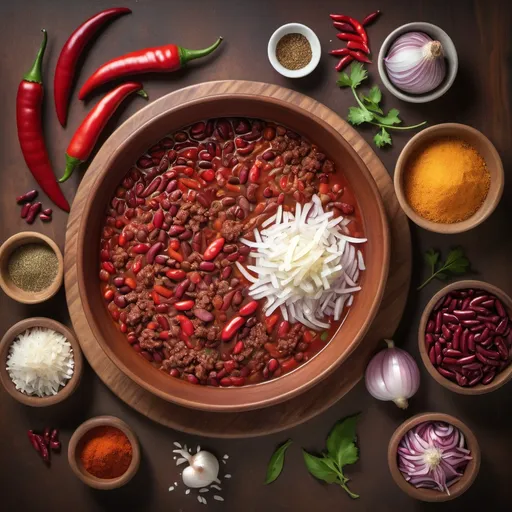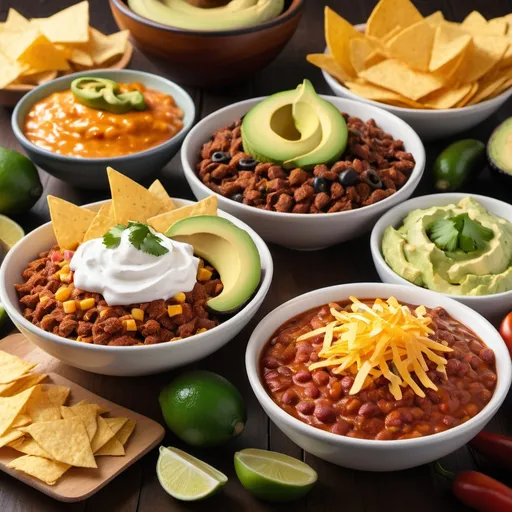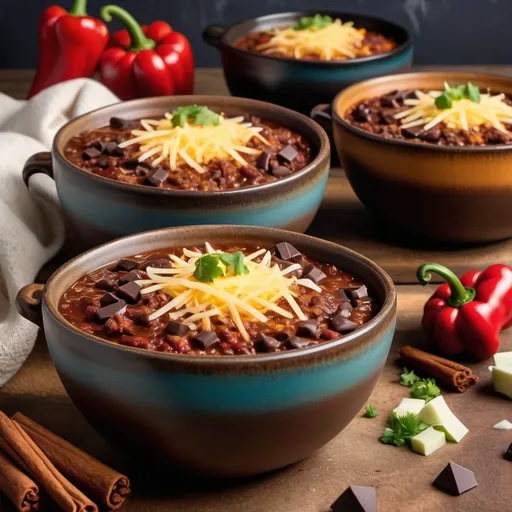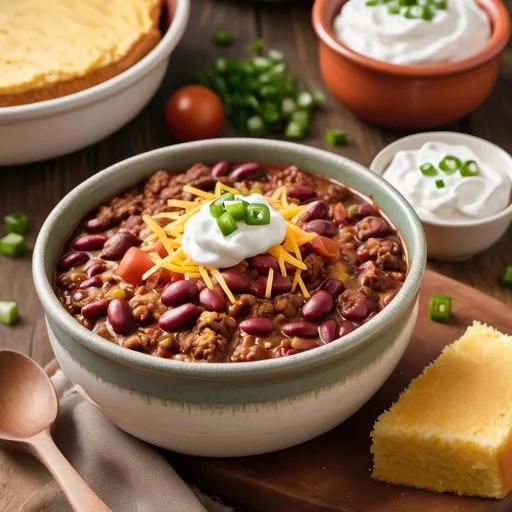A Confort Food Favorite
There’s something magical about a bowl of chili. Whether it’s a cold winter night or a backyard cookout, chili has a way of bringing people together. It’s warm, hearty, and packed with flavor. But here’s the deal—making a great chili isn’t just about throwing random ingredients into a pot. It’s about balance, the right spices, and avoiding common mistakes.
So, if you’ve ever wondered why your chili lacks depth or why it’s too watery, you’re in the right place! This guide will walk you through everything you need to know—from different chili variations to cooking methods and secret ingredients. Let’s dive in!
Popular Types of Chili Around the World
Chili isn’t just one dish—it has evolved into multiple variations depending on region, culture, and personal preference. Here are some of the most loved types of chili you should know:

Classic Chili Con Carne
This is the OG of chili! Chili con carne (literally “chili with meat”) is a Tex-Mex staple made with ground or cubed beef, tomatoes, chili peppers, and spices. Some versions include beans, but Texans will tell you that’s a crime! Want to make it traditional? Keep it simple—no beans, just meat and bold flavors.
Vegetarian and Vegan Chili
Who says you need meat to make a killer chili? A vegetarian version swaps out beef for hearty alternatives like lentils, mushrooms, or tofu. For a vegan twist, skip dairy toppings like sour cream and cheese. Trust me, with the right seasoning, you won’t even miss the meat!
White Chicken Chili: A Unique Twist
If you love chili but want something lighter, white chicken chili is for you. Instead of a tomato-based broth, this version uses a creamy base (sometimes with cream cheese or coconut milk), white beans, and shredded chicken. It’s mild but still packed with flavor!
Texas-Style Chili vs. Other Regional Variations
- Texas Chili: No beans, no tomatoes—just meat, chili peppers, and spices.
- Cincinnati Chili: A Greek-inspired twist, often served over spaghetti and topped with shredded cheese.
- New Mexico Chili: Features fresh or dried Hatch green chiles for a smoky, spicy kick.
- Midwest Chili: Includes a mix of beans, ground beef, and a sweeter tomato base.
How to Make the Perfect Chili: Step-by-Step Guide
Now that you know the different types of chili, let’s get to the fun part—cooking! But before you grab your pot, let’s break it down step by step.
Essential Ingredients for a Flavorful Chili
« A great chili starts with the right ingredients. If you want deep, rich flavors, focus on quality spices, fresh vegetables, and good protein sources. »

| Ingredient | Purpose |
|---|---|
| Ground Beef or Turkey | The heart of most chili recipes. Turkey offers a leaner option. |
| Tomatoes | Crushed, diced, or pureed—they form the chili’s base. |
| Chili Peppers | Jalapeños, chipotle, or dried chiles add heat and depth. |
| Beans | Optional but great for texture. Black, kidney, or pinto beans work well. |
| Onions & Garlic | Enhance the flavor with their natural sweetness and aroma. |
| Spices | Chili powder, cumin, paprika, and cayenne make all the difference. |
| Broth or Beer | Adds richness and keeps the chili from drying out. |
Choosing the Right Meat (or Meat Alternatives)
The type of protein you use will shape your chili’s texture and taste. Here are some options:
- Ground Beef: The classic choice, usually 80/20 for the right fat content.
- Chuck Roast: If you prefer chunks of meat instead of ground beef, slow-cooked chuck roast is amazing.
- Ground Turkey: A leaner alternative but can be bland—season it well!
- Pork: Some people mix ground pork with beef for extra juiciness.
- Plant-Based Crumbles: A great vegan substitute that mimics ground beef.
The Secret to a Perfectly Thick Chili
Nobody wants a watery chili! Here’s how to get that rich, thick consistency:
- Simmer Longer: The longer chili cooks, the thicker it gets.
- Use Less Liquid: Start with a little broth and add more as needed.
- Mash Some Beans: Blending a portion of the beans helps create a thicker texture.
- Add Cornmeal or Masa Harina: A small spoonful adds body and a slight corn flavor.
Slow Cooker vs. Instant Pot vs. Stovetop Cooking
How you cook your chili matters! Each method has its perks:
- Slow Cooker: Best for deep flavors. Cook on low for 6-8 hours.
- Instant Pot: A quick method—your chili is ready in under an hour!
- Stovetop: Classic and reliable, but requires stirring and monitoring.
Common Chili Mistakes and How to Avoid Them
Even experienced cooks can make mistakes when preparing chili. If you’ve ever ended up with bland, watery, or overly spicy chili, don’t worry—you’re not alone! Let’s go over some of the most common mistakes and how to fix them.
Why Your Chili Tastes Bland (And How to Fix It)
There’s nothing worse than a chili that lacks depth and flavor. The problem? Usually, it’s either a lack of spices or not enough cooking time.
« A great chili needs time to develop flavors. If it tastes bland, let it simmer longer and adjust your seasoning. »
Here’s how to enhance your chili:
- Boost the Spices: Chili powder, cumin, paprika, and cayenne are your best friends. Toasting them in a dry pan before adding them to your chili intensifies their flavor.
- Add a Secret Ingredient: A pinch of cinnamon, dark chocolate, or a splash of beer can add unexpected richness.
- Simmer Longer: The longer chili cooks, the more the flavors blend. Let it cook for at least an hour.
Dealing with Too Much Spiciness
Accidentally made your chili too hot? Don’t panic—there are easy fixes.
- Add Dairy: A spoonful of sour cream or shredded cheese can mellow the heat.
- Increase the Base: Adding more tomatoes, beans, or broth can dilute the spice level.
- Sugar or Acid Balance: A teaspoon of sugar or a squeeze of lime juice can counteract excess heat.
How to Prevent Chili from Being Too Watery
If your chili is looking more like soup than a thick stew, here’s how to fix it:
- Let It Simmer: Remove the lid and let your chili cook down for another 20-30 minutes.
- Add a Thickener: Cornmeal, masa harina, or even a mashed potato can help thicken chili.
- Use Less Liquid: If using canned tomatoes or broth, start with less and add more only if needed.
Overcooked vs. Undercooked Beans
Beans can make or break a chili. If they’re too hard, they weren’t cooked long enough. If they’re mushy, they were overcooked.
- Use Canned Beans for Convenience: Drain and rinse them before adding to the chili.
- For Dried Beans: Soak them overnight and cook separately before adding to your chili.
Best Chili Toppings and Serving Suggestions
Now that you’ve got the perfect chili, let’s talk about toppings! The right garnish can take your bowl from good to unforgettable.

The Ultimate Chili Toppings
| Topping | Why It Works |
|---|---|
| Shredded Cheese | Makes chili creamy and adds a rich, savory flavor. |
| Sour Cream | Balances the spice and adds a cool, tangy contrast. |
| Avocado | Brings a fresh, creamy texture to spicy chili. |
| Crushed Tortilla Chips | Adds crunch and a salty kick. |
| Jalapeños | For those who love extra heat! |
| Cilantro | Gives a fresh, herby taste that brightens up the chili. |
Perfect Side Dishes to Pair with Chili
Chili is delicious on its own, but pairing it with the right side dish makes it even better. Try these options:
- Cornbread: A slightly sweet, soft bread that balances the spice of chili.
- Rice: Helps stretch the chili and absorb the flavors.
- Baked Potatoes: Spoon chili over a baked potato for a filling meal.
- Garlic Bread: Perfect for dipping into thick chili.
How to Serve Chili for a Crowd
Hosting a party? Chili is one of the easiest dishes to make in bulk. Here are a few tips:
- Set Up a Chili Bar: Serve chili with various toppings so guests can customize their bowls.
- Use a Slow Cooker: Keeps chili warm for hours without overcooking.
- Offer Different Heat Levels: Make a mild version and serve hot sauce or extra jalapeños on the side.
Health Benefits of Chili: Is It Good for You?
Chili isn’t just delicious—it’s packed with nutrients and health benefits! From boosting metabolism to strengthening the immune system, let’s explore why adding chili to your diet is a smart choice.

Nutritional Benefits of Chili Ingredients
Chili is loaded with healthy ingredients that provide essential vitamins and minerals. Here’s a breakdown of its nutritional value:
| Ingredient | Health Benefits |
|---|---|
| Chili Peppers | Rich in capsaicin, which may boost metabolism and reduce inflammation. |
| Tomatoes | Packed with antioxidants like lycopene, which promotes heart health. |
| Beans | High in fiber, which aids digestion and helps regulate blood sugar. |
| Lean Protein (Beef, Chicken, Turkey) | Provides essential amino acids for muscle growth and repair. |
| Garlic & Onions | Contain compounds that support the immune system and heart health. |
The Role of Spicy Peppers in Metabolism and Health
« Capsaicin, the compound responsible for chili’s heat, has been linked to fat burning and appetite suppression. If you love spicy food, you may also be giving your metabolism a natural boost! »
Studies suggest that eating spicy foods may:
- Increase calorie burning for a short period after eating.
- Help curb cravings and reduce overall food intake.
- Lower blood pressure and improve circulation.
Fun Variations and Creative Chili Recipes
Chili doesn’t have to be the same every time! Here are some fun ways to switch up your chili recipe:
Sweet and Spicy Chili: Adding Chocolate or Cinnamon
Believe it or not, adding dark chocolate or a pinch of cinnamon to chili enhances its richness and balances the spice. This trick is commonly used in Mexican-style chili, adding depth and complexity to the dish.
Keto and Low-Carb Chili Alternatives
If you’re following a low-carb diet, skip the beans and try these keto-friendly options:
- Extra Meat: Replace beans with more ground beef, turkey, or pork.
- Cauliflower Rice: Use it as a thickener instead of traditional starches.
- Heavy Cream or Cheese: Add creaminess while keeping it low-carb.
Chili for Meal Prep: Best Storage and Reheating Tips
Chili makes an excellent meal prep dish since it tastes even better the next day! Here’s how to store and reheat it:
- In the Fridge: Store in an airtight container for up to 5 days.
- In the Freezer: Freeze in portion-sized containers for up to 3 months.
- Reheating: Thaw overnight in the fridge and reheat on the stove or in the microwave.

Frequently Asked Questions About Chili
Can You Freeze Chili? Best Storage Tips
Yes! Chili freezes well and actually tastes better after sitting for a while. Here are some quick freezing tips:
- Let it cool completely before freezing.
- Use airtight containers or freezer bags to prevent freezer burn.
- Label with the date so you know when to use it.
How Long Does Chili Last in the Fridge?
Chili stays fresh in the refrigerator for **4-5 days** when stored properly. Always use a sealed container to prevent it from absorbing odors from the fridge.
What’s the Best Meat for Chili?
The best meat depends on personal preference:
- Ground Beef (80/20): Classic and full of flavor.
- Chuck Roast: For a chunkier, slow-cooked texture.
- Ground Turkey: Leaner but needs extra seasoning.
- Ground Pork or Sausage: Adds a unique depth of flavor.
Conclusion: Mastering the Art of Chili Cooking
Chili is more than just a dish—it’s a tradition, a comfort food, and a versatile meal that can be customized to suit any taste. Whether you love it spicy, mild, with beans, or without, the key is balancing flavors and cooking it just right.
Now that you have all the knowledge, it’s time to get into the kitchen and make your perfect chili. Experiment with flavors, try different toppings, and most importantly, enjoy every spoonful!

